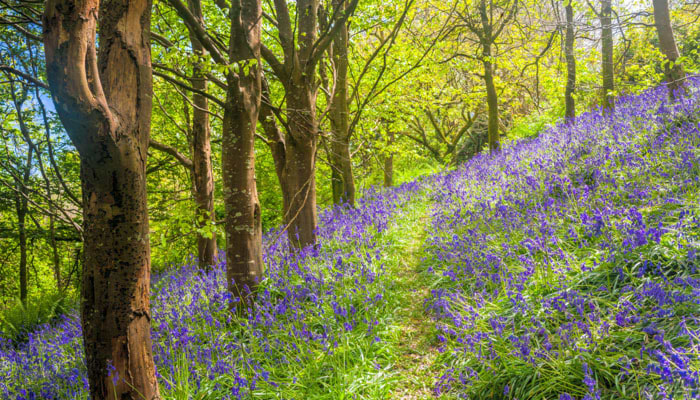
© Ian Woolcock / Adobe Stock
If you do only one thing this spring, make sure you experience the breathtaking carpets of beautiful bluebells springing up all over Cornwall. While one bluebell on its own is an undeniably pretty flower, with its delicate, shimmering blue hue, en masse, they transform the woodland into an enchanted wonderland. The National Trust leads bluebell conservation in the UK, as 25% of its woodland is semi-natural or ancient, thus providing an ideal environment. Almost half of the world's bluebells grow in the UK and the colonies take around five to seven years to establish. Bluebells flower in spring, bringing woods and hedgerows to life in April and continuing through until late May. In these months, they are able to make the most of the sunlight, which can filter through to the woodland floor before the full canopy grows and casts its shade. History and folklore The history of bluebells can be traced back to the Bronze Age, as archaeological evidence has revealed that the people used glue made from bluebells to attach tail feathers to their arrows. Bluebells are known for the gummy sap contained in their bulbs. This was also used as glue to bind books. There are a lot of ancient myths attached to bluebells. They were also known as "fairy flowers", as they were said to be used by the fairies to lure and trap children in the woods! In ancient times, it was thought to be unlucky to walk through a bluebell wood, because it was filled with spells. This is the origin of the myth that it's unlucky to pick bluebells to bring them into the house. However, bluebells are also known as blessed flowers, as their Latin name is Endymion, the lover of the moon goddess, Selene. Endymion was put into an eternal sleep by Selene, so she alone could enjoy his beauty. Thus herbalists believed bluebells would help prevent nightmares. In the past, they were known as a herbal cure for tuberculosis, leprosy and spider-bites - and yet the bluebell is poisonous if eaten. Legend has it that if you wear a wreath of bluebells, you'll be compelled to speak only the truth. It's also said that if you can turn one of the flowers inside-out without breaking it, you will be able to win the person that you desire. Types of bluebell There are native and non-native bluebells in the UK. The Spanish bluebell has been introduced to gardens, but is in danger of eclipsing our native species by escaping into the wild. You can tell the two species apart by looking at the colour of the pollen. The Spanish bluebell (known as Hyacinthoides Hispanica) will have pale green or blue pollen. The pollen of the native bluebell is a creamy-white colour. With a drooping stem that hangs to one side, the native flower has a sweet aroma, while the non-native flower’s stem is stiff and upright, and almost odourless. It is illegal to pick, uproot or destroy bluebells, as they are protected by law. Where to find bluebells All over Cornwall, beautiful bluebells are blooming in the spring and there are some wonderful places to go for scenic walks. Some of the most stunning walks include Lanhydrock Estate, in Bodmin, where almost every inch of the woodland floor is blue, going right across the estate as far as the Fowey River. Tehidy Country Park, in Camborne, is west Cornwall's largest area of woodland, boasting 250 acres of woods and nine miles of paths. It is a particularly beautiful place to visit in April and May, thanks to its abundance of bluebells. Penrose Estate, at Helston, is run by the National Trust. With a mix of woodland and rich farmland around Loe Pool, Cornwall's largest freshwater lake, it's a lovely place for bluebells in spring, with plenty of paths to explore. The Lost Gardens of Heligan, in St Austell, are among the finest gardens in Cornwall and spring is a great time of year to visit, as the woodland walk is in full bloom. There are many more bluebell-adorned walks across Cornwall, which just so happens to be one of the most picturesque places on earth – and we’re not just saying that: it’s absolutely incredible here in the spring! Griggs' country store, in the heart of Cornwall, can provide everything you need for the great outdoors, including suitable clothing for spring walks. Please contact us for further information on our range of quality branded products.




